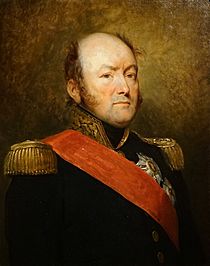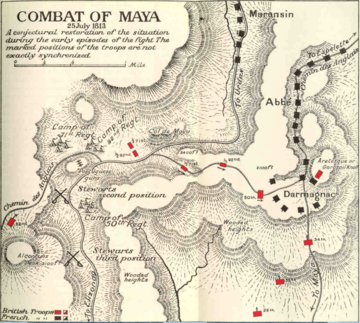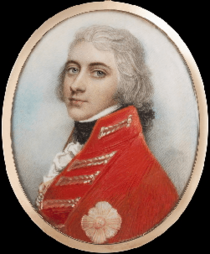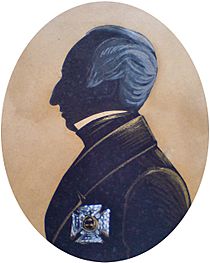Battle of Maya facts for kids
Quick facts for kids Battle of Maya |
|||||||
|---|---|---|---|---|---|---|---|
| Part of the Peninsular War | |||||||
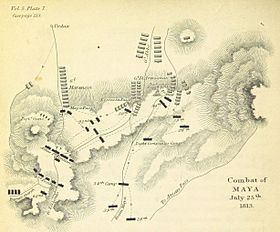 Combat of Maya |
|||||||
|
|||||||
| Belligerents | |||||||
| Commanders and leaders | |||||||
| Strength | |||||||
| 21,000 | 6,000 4 guns |
||||||
| Casualties and losses | |||||||
| 2,100 | 1,488 4 guns |
||||||
The Battle of Maya happened on July 25, 1813. It was a fight during the Peninsular War in the Pyrenees mountains. A French army, led by Jean-Baptiste Drouet, Comte d'Erlon, attacked British soldiers. These British troops were part of the British 2nd Division, commanded by William Stewart.
Even though the British were surprised and had fewer soldiers, they fought bravely. They caused more losses to the French than they suffered themselves. By the afternoon, the French started to win. But then, a group of soldiers from the British 7th Division arrived. This helped the British hold their ground. That night, the British quietly left the area. The French did not chase them very well. The Battle of Maya was part of a bigger series of fights called the Battle of the Pyrenees. This larger battle ended with a big victory for the British and their allies.
Contents
Why Did the Battle of Maya Happen?
After the Battle of Vitoria
Arthur Wellesley, Marquess Wellington led the Allied army. He won a huge victory against the French at the Battle of Vitoria on June 21, 1813. The French army was led by King Joseph Bonaparte and Marshal Jean-Baptiste Jourdan. The Allies lost about 5,000 men, but the French lost 8,000 soldiers. The Allies also captured almost all of the French cannons.
This victory meant that King Joseph's rule in Spain was over. It also made other countries feel brave enough to keep fighting against Emperor Napoleon. After Vitoria, two important French forts in Spain were still held by French soldiers: San Sebastián and Pamplona. Wellington started to attack San Sebastián with his big siege cannons. At the same time, Spanish troops surrounded Pamplona. They didn't have siege cannons, so they planned to starve the French soldiers inside the fort until they gave up.
The French Army Gets a New Commander
On July 12, 1813, Marshal Jean-de-Dieu Soult became the new commander of the French army. He quickly changed how the army was set up. He gathered 72,000 foot soldiers and 7,000 cavalry (horse soldiers). He organized them into a new "Army of Spain." This army had a Reserve group and three main fighting groups called "lieutenancies" or army corps.
Napoleon told Soult to "fix things in Spain" and save Pamplona and San Sebastián. At Vitoria, the French lost 151 cannons. But they saved their horses. This made it easy to get new cannons from the large supply in Bayonne. The French army got 140 new cannons for their different divisions.
Jean-Baptiste Drouet, Comte d'Erlon was put in charge of the Center lieutenancy, which had almost 21,000 men. This group included divisions led by Jean Barthélemy Darmagnac, Louis Jean Nicolas Abbé, and Jean-Pierre Maransin. Honoré Charles Reille led the Right lieutenancy with over 17,000 men. Bertrand Clausel led the Left lieutenancy, also with over 17,000 men. The Reserve group, with over 17,000 men, was led by Eugène-Casimir Villatte. There were also over 7,000 cavalry soldiers. It's a bit confusing, but d'Erlon's "Center" group actually fought on the right side in July 1813.
Allied Positions and French Plans
On July 8, the French left the Maya Pass. Rowland Hill and his British soldiers took control of the pass. Portuguese soldiers held other passes nearby. By the end of July, the Allied forces were spread out. The British 5th Division was attacking San Sebastián. Other British and Spanish units were defending the coast. The British 2nd Division held Maya Pass.
Wellington was worried about having to defend two forts at once. He felt his army was "not as strong as we ought to be."
Marshal Soult wanted to rescue Pamplona. His plan was to send d'Erlon's troops to attack Maya Pass. At the same time, Reille and Clausel would attack Roncevaux Pass, which was further southeast. Villatte's troops would make a fake attack along the coast to distract the Allies. After breaking through the passes, the French armies would meet up at Pamplona. Heavy rains washed out a bridge, so the attack started a day late.
The Battle of Maya: What Happened?
The Allied Defenses at Maya Pass
General Hill was in charge of the Allied defenses around Maya Pass. The Maya Pass itself was defended by two British brigades from William Stewart's 2nd Division. These were led by William Henry Pringle and John Cameron. Another Portuguese brigade was further south.
Historian Charles Oman said that Stewart's defenses were "ludicrously incomplete." The French had a large army only 4 miles (6.4 km) away, but the British didn't send out regular patrols to check. Cameron's brigade, with four Portuguese cannons, was in a good spot on the main road. But on the eastern side of the pass, there was only a small group of 80 men. Pringle's brigade was camped 2.5 miles (4 km) south in Maya village.
The French Surprise Attack
To distract the Allies, Soult ordered a fake attack at Aldudes. Early on July 25, 1813, Campbell's brigade easily defeated these poorly trained French soldiers. General Hill heard the gunfire and rode to Aldudes to see what was happening. This took him away from Maya Pass.
Even worse, General Stewart also heard the gunfire and rode south to Aldudes. This left the 2nd Division without its leader. Command of the division went to Brigadier General Pringle, who had only arrived in Spain two days before and didn't know the area well.
The main road over Maya Pass goes up from the French side to the Spanish village of Urdax. Then it rises to the pass before going down towards Elizondo. D'Erlon planned to use the hidden ground in front of the Maya ridge. He sent Maransin's division up the main road, telling them to stay hidden. The other two divisions would attack the eastern end of the ridge first. Darmagnac's division marched from Espelette, with Abbé's division right behind them.
Fighting on the Eastern Ridge
A British officer reported seeing movement in the distance. The four light infantry companies were called up, increasing the defenders on the knoll from 80 to 400 men. At 10:30 am, d'Erlon sent eight light infantry companies from Darmagnac's division forward. They burst from cover and surrounded the Aretesque knoll. The 16th Light Infantry Regiment followed them.
The British were surprised but fought hard, pushing back several French attacks. While this was happening, Darmagnac's division moved past the knoll to reach the eastern top of the ridge. The 8th Line Infantry Regiment circled behind the knoll to trap the British. After 45 minutes, the British light infantry companies and the picket were wiped out. They had 260 killed or wounded, and 146 men captured.
Pringle rode to join Cameron's brigade at the western end of Maya ridge. Pringle's battalions marched up the steep path to the eastern end of the ridge, joining the fight one by one. The 34th Foot arrived first but couldn't push the French off the ridge. A soldier from the 34th said the path was "narrow, steep and tiresome." He added, "our comrades [the light infantry] were all killed, wounded or prisoners."
After 11:00 am, the Portuguese cannons began to fire. This was a signal that Maya Pass was under attack. Pringle ordered the 50th Foot from Cameron's brigade to move east along the ridge. They tried to push back Darmagnac's battalions. The 39th Foot and the 28th Foot were the next battalions from Pringle's brigade to attack Darmagnac's division from the valley.
As the 50th Foot was forced back, Pringle sent nearly 400 men from the 92nd Foot (Gordon Highlanders) to attack Darmagnac's troops. The British general personally helped plan the 92nd's attack with the 28th, which had just reached the Maya ridge. The Highlanders and the French fought a fierce gun battle from about 120 yards (110 m) away. The French probably lost more men, but they had more soldiers. The Highlanders lost 60% of their men and had to retreat west. The 28th Foot also started to retreat downhill towards Maya village, joined by the 34th Foot and possibly the 39th Foot.
Fighting on the Western Ridge
D'Erlon sent two battalions downhill to chase Pringle's retreating brigade. Most of Darmagnac's division began pushing west along the ridge top. By this time, Maransin's division appeared on the main road. Abbé's division was right behind Darmagnac's.
Cameron sent soldiers from the 71st Foot (Highlanders) to stop Darmagnac's division. The 71st fired a very effective first volley. But the French tried to surround the Highlanders on both sides, forcing them back. At 2:00 pm, Stewart finally arrived. He saw that the British position was in danger. Realizing the pass was almost lost, he ordered his troops to pull back from the top of the ridge. He hoped to form a new line further back. He also hoped for help from the 7th Division, to whom Pringle had sent urgent requests.
In the confusion, two Portuguese cannons were captured as they tried to retreat. The crews of the other two cannons, seeing they were about to be taken, pushed their guns into a ravine. These were the only cannons Wellington lost in battle. He blamed Stewart for canceling an earlier order by Pringle to pull the guns back.
Darmagnac's division was exhausted from fighting. Maransin's division took its place at the front, with Abbé's division supporting it. It took time for Maransin's troops to get into position, so there was a half-hour break in the fighting. Below the top of the pass, Stewart set up his first line of defense across the main road. His second line was 300 yards (270 m) behind the first.
After 3:00 pm, Maransin's division attacked Stewart's new position. The first line of British soldiers fired their guns, then pulled back behind the second line to regroup. Then the new first line did the same thing. During this, Cameron's brigade gave up about 0.5 miles (0.8 km) of ground. When the French overran the British camps, many French soldiers stopped to steal from the tents. This looting and the rows of tents messed up the French formation, causing another pause in the fighting.
Maransin's division moved forward again around 4:30 pm. But they were suddenly stopped by a counterattack from the newly arrived 82nd Foot. This battalion from the 7th Division had been nearby and finally got permission to join the fight. After a short break, the French regrouped and started pushing back again. Around this time, Stewart was shot in the leg, but he insisted on staying in command.
At 6:00 pm, the 6th Foot and the Brunswick Oels arrived from the west. These 1,500 soldiers attacked Maransin's division from an unexpected direction. The French 103rd Line Infantry battalion was badly hurt, losing 15 out of 20 officers. The 82nd Foot and the remaining soldiers of Cameron's brigade regrouped and attacked again. They pushed Maransin's surprised soldiers uphill.
Finally, D'Erlon sent in one of Abbé's fresh brigades. Maransin's troops regrouped behind them. The French commander also called back one of Darmagnac's brigades that had been chasing Pringle's men. D'Erlon thought he was facing two full British divisions, so he decided not to send Abbé's division to attack. The battle slowly ended around 8:00 pm. The French had control of Maya Pass, but the British were still holding positions nearby.
What Was the Result of the Battle?
General Hill arrived soon after the fighting stopped. He had already seen a message about the Battle of Roncesvalles that day. The message said that 35,000 French soldiers had attacked, and the Allies had to retreat south towards Pamplona. With Roncevaux Pass now open, Hill ordered Stewart and Barnes to retreat. They quietly left at midnight and marched to Elizondo. The British had been fighting for ten hours, so they had to leave behind their seriously wounded. Many soldiers also got separated from their units.
The next morning, d'Erlon expected another fight, so the French didn't chase the British until long after sunrise. D'Erlon said he had won a victory, but he said it in a humble way. Historian Michael Glover said Stewart's "defense was mismanaged."
The French suffered more losses. Darmagnac's division had 1,400 casualties out of 6,900 soldiers. Maransin's division lost 600 out of 6,000. Abbé's division lost 100 out of 8,000, including a brigade commander who was wounded.
The British and Allied forces had fewer casualties. Cameron's brigade lost 800 out of 1,900 soldiers. Pringle's brigade lost 530 out of 2,000. Barnes's brigade and the 82nd Foot lost only 140. In total, 6,000 British soldiers fought, and they lost four cannons. British losses were 144 killed, 994 wounded, and 350 missing, for a total of 1,488. There were no Portuguese losses listed.
Later, Wellington admitted that splitting his forces to attack both San Sebastián and Pamplona at the same time was "one of the greatest faults he ever committed in war."
Who Fought at Maya Pass?
French Army at Maya Pass
This table shows the French forces that fought at Maya Pass in July 1813.
| Corps | Division | Strength | Casualties | Brigade | Units |
|---|---|---|---|---|---|
| Center: General of Division Jean-Baptiste Drouet d'Erlon |
2nd Division: General of Division Jean Barthélemy Darmagnac |
6,961 | 1,400 | General of Brigade David Hendrik Chassé |
16th Light Infantry Regiment, 1 battalion |
| 8th Line Infantry Regiment, 1 battalion | |||||
| 28th Line Infantry Regiment, 2 battalions | |||||
| General of Brigade Nicolas Gruardet |
51st Line Infantry Regiment, 1 battalion | ||||
| 54th Line Infantry Regiment, 1 battalion | |||||
| 75th Line Infantry Regiment, 2 battalions | |||||
| 3rd Division: General of Division Louis Jean Nicolas Abbé |
8,030 | 100 | General of Brigade Antoine Rignoux (WIA) |
27th Light Infantry Regiment, 1 battalion | |
| 63rd Line Infantry Regiment, 1 battalion | |||||
| 64th Line Infantry Regiment, 2 battalions | |||||
| General of Brigade Charles-François Rémond |
5th Light Infantry Regiment, 2 battalions | ||||
| 94th Line Infantry Regiment, 2 battalions | |||||
| 95th Line Infantry Regiment, 1 battalion | |||||
| 6th Division: General of Division Jean-Pierre Maransin |
5,966 | 600 | General of Brigade Louis Paul Baille de Saint-Pol |
21st Light Infantry Regiment, 1 battalion | |
| 24th Line Infantry Regiment, 1 battalion | |||||
| 96th Line Infantry Regiment, 1 battalion | |||||
| General of Brigade Georges Alexis Mocquery |
28th Light Infantry Regiment, 1 battalion | ||||
| 101st Line Infantry Regiment, 2 battalions | |||||
| 103rd Line Infantry Regiment, 1 battalion |
Allied Army at Maya Pass
This table shows the Allied forces that fought at Maya Pass.
| Corps | Division | Brigade | Units | Casualties |
|---|---|---|---|---|
| Hill's Corps: Lieutenant General Rowland Hill |
2nd Division: Lieutenant General William Stewart |
Major General William Henry Pringle |
28th Foot Regiment, 1st Battalion | 159 |
| 34th Foot Regiment, 2nd Battalion | 168 | |||
| 39th Foot Regiment, 1st Battalion | 186 | |||
| 60th Foot, 5th Battalion, 1 company | 44 | |||
| Da Cunha's Portuguese Battery | 15 | |||
| Lieutenant Colonel John Cameron |
50th Foot Regiment, 1st Battalion | 249 | ||
| 71st Foot Regiment, 1st Battalion | 196 | |||
| 92nd Foot Regiment, 1st Battalion | 343 | |||
| 60th Foot, 5th Battalion, 1 company | see above | |||
| 7th Division: Lieutenant General George Ramsay, 9th Earl of Dalhousie |
Major General Edward Barnes |
6th Foot Regiment, 1st Battalion | 21 | |
| Brunswick Oels Regiment | 41 | |||
| Unattached | 82nd Foot Regiment, 1st Battalion | 79 |
Images for kids


